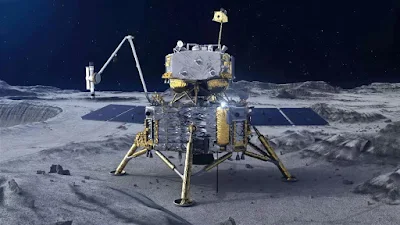Chang’e 5 is on the last leg of its mission on the moon. After a visit to the lunar surface lasting less than 48 hours, it is back in orbit around the moon and ready to bring its samples home so that scientists on Earth can analyse them.
The spacecraft consists of an orbiter, re-entry capsule, a lander and ascent stage, and launched on 23 November aboard a Long March 5 rocket. It landed on the moon on 1 December. It is China’s first sample return mission, making the nation only the third – after the US and the Soviet Union – to bring back rocks and dust from the moon. The most recent mission to bring back lunar samples was the Soviet Luna 24 probe in 1976.
Chang’e 5 landed in an unexplored area of the moon called Oceanus Procellarum, or the Ocean of Storms. “It’s a region where there are these really volcanically young landforms, and we currently don’t have samples in the Apollo samples or the Russian samples that have anything like that, so these samples will really enable some new science,” says Kerri Donaldson Hanna at the University of Central Florida in the US.
Most of the areas that have been sampled on the moon are about 3 billion years old or older. Scientists estimate that the rocks in Chang’e 5’s landing area are less than 2 billion years old based on the layering of craters in the area. Once we get the samples back to Earth, we’ll have a better idea of how old these volcanic rocks are.
That’s crucial because on other worlds, the only way we can tell the age of an area on the surface is by analysing the craters – there is no direct way to confirm those ages. By comparing the age directly measured from the samples to the age inferred from craters on the moon, we can create a link between those methods of analysis that will also be useful on other crater-pocked worlds like Mars or Mercury...
-

No comments:
Post a Comment
Only News